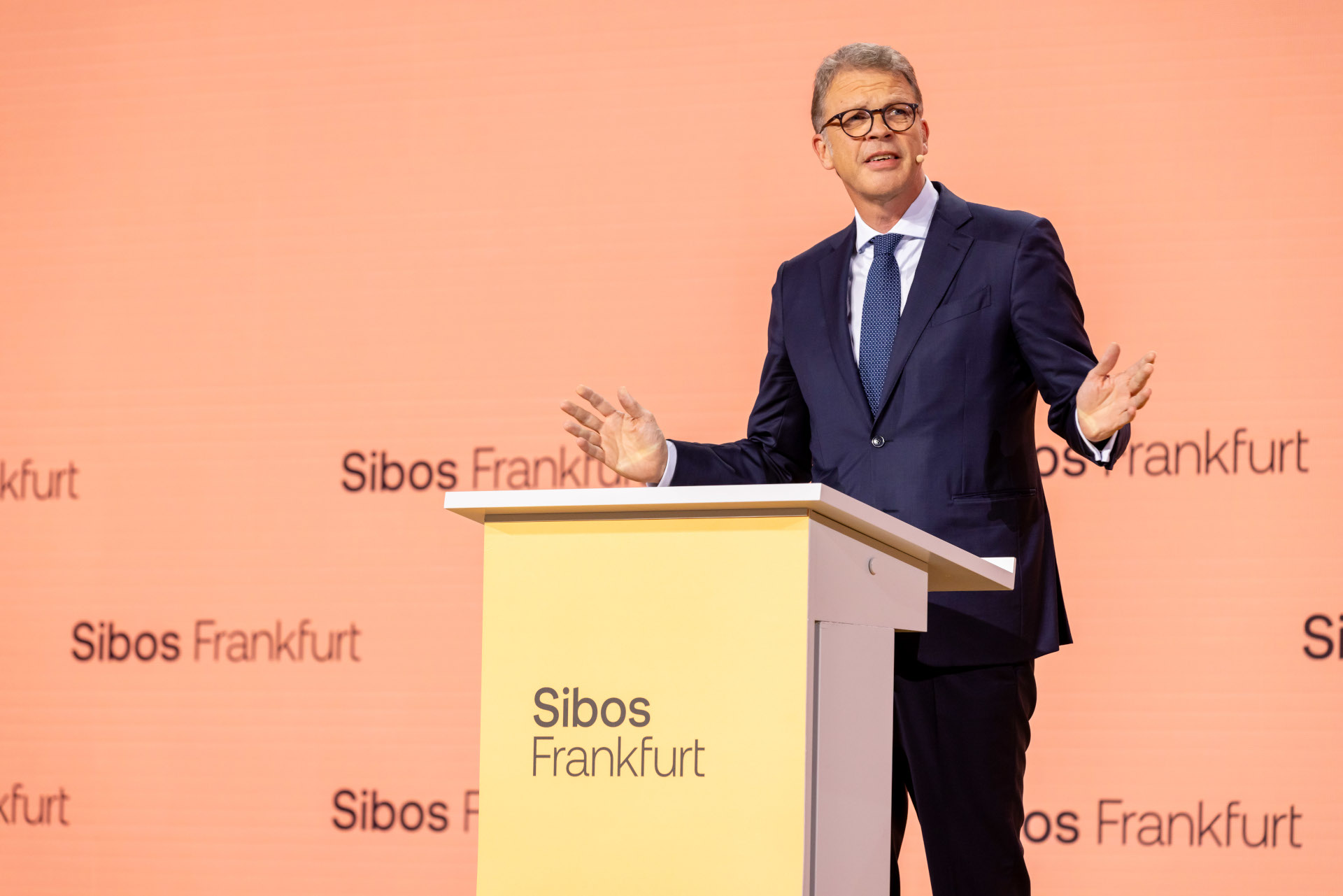21 October 2025
As Sibos Frankfurt 2025 got underway in Deutsche Bank’s home city, flow’s Clarissa Dann heard how past predictions of how the future of global finance might develop have proved accurate, and what the community is embracing now to be fit for purpose tomorrow
MINUTES min read
Six years ago, Deutsche Bank CEO Christian Sewing told Sibos London 2019 delegates that “collaboration and innovation will drive transaction banking success” and “if we embrace technology, work together and keep clients at the centre of everything we do, I believe transaction banks have a bright future”.1
The Swift International Banking Operations Seminar (Sibos) community appears to have listened. This year, 12,500 delegates descended on the vast Messe Frankfurt for Sibos 2025 to hear more about ‘the next frontiers of global finance’. Announced on 29 September (Day 1), Swift’s example of collaboration and innovation between 30 financial institutions – the addition of a blockchain ledger to its infrastructure stack – hit the newswires.2
Returning to the keynote podium in his home city, Sewing congratulated Swift on the digital ledger and highlighted how the organisation leads the dialogue in our industry “with both vision and commitment”.
“As payments have increasingly become a geopolitical instrument, Swift has moved into the spotlight – particularly in the context of global sanctions,” he continued. At the same time the transaction banking industry is undergoing a rapid transition to digital finance.

Deutsche Bank CEO Christian Sewing addresses Sibos Frankfurt 2025
No longer just lenders, but innovators
Against this backdrop the role of banks has expanded far beyond their traditional remit. “We are no longer just lenders of projects. We are strategic partners helping reshape economies,” Sewing explained. “We act as infrastructure providers, as risk managers, as technology investors and as sustainability financiers. In short, banks have become the connective tissue of a hyper-connected economy.”
The question, therefore, is no longer one of relevance – if anything, transaction banking has become more indispensable than ever. Technology, reflected Sewing, now sits at its core; “competitors have become collaborators; and banks have continued to guide clients through a period of extraordinary disruption”. As for artificial intelligence (AI), it’s still early days – “We all know AI will be a game changer,” he noted, “even if we still lack the imagination of exactly how it will reshape our world.”
Swift CEO Javier Pérez-Tasso had earlier acknowledged that while Swift continued its “relentless focus on the fundamentals of operational excellence, regulatory compliance and governance”, it needed at the same time to “get ready for the future”. Pérez-Tasso reminded delegates of Swift’s two parallel tracks of remaining relevant across many generations while innovating and staying “one step ahead” – themes previously referenced in his 2020 flow profile, ‘Responsible innovation’.
As for the frontiers of global finance, they are “not far away”, he said. “We are seeing big changes already: a shift in global trade and economic policies; the rise of AI and DeFi, regulation and deregulation.” In addition, we are hearing “a huge buzz around the future of tokenised assets and, off the back of new policy frameworks, momentum around central bank digital currencies and stablecoins.” The conference programme across the four days reflected these trends.

'Building the bank of tomorrow: Part 2' Panellists from left to right: Megha Kansal, Senior Partner at McKinsey & Company (moderator); Toby Brown, Global Head of Regulated Industry Solutions at Google Cloud; Victoria Cleland, Chief Cashier and Executive Director of Payments for the Bank of England; Debopama Sen, Head of Payments – Treasury and Trade Solutions at Citi; Patricia Sullivan, Global Head of Institutional Cash Management, Deutsche Bank; and Raj Seshadri, Chief Commercial Payments Officer for Mastercard
Building the bank of the future
This stance of looking back while looking forward while innovating responsibly played out in the Day 2 Industry session, ‘Building the bank of tomorrow: Part 2’. Those looking for Part 1 had to go back 12 months to the popular session at Sibos 2024 Beijing that looked at how AI was driving change, and how technology was disrupting the world of payments in banking. While digital assets were mentioned, the most pressing call to action for banks and payment providers was to “provide an intuitive layer of customer experience on top of all this complexity”.
Megha Kansal, Senior Partner at McKinsey & Company moderated Part 2, reflecting that while a year has passed, the 2024 themes are unchanged. She noted that “digital assets have crystallised into stablecoins, AI has become generative AI, and the need for intuitive customer experience from providers is more acute than ever.”
Working with platforms and AI
Kansal opened the panel session with the observation that AI and the Cloud attracted a great deal of hype, with banks experimenting with both but too often hampered by siloed data. Google Cloud’s Toby Brown suggested that widespread scepticism over AI’s ability to add value had disappeared in many financial institutions, as his company noted in its recent report The ROI of AI 2025.3 However, maximising the value of AI was contingent on investing heavily in the real-time architecture needed to produce high quality data.
Citi’s Debopama Sen reported that as a bank handling millions of payments daily the group relied on multi-cloud AI, which needed smart data rather than siloed data that complied with local Cloud regulations and jurisdictions. The bank also had to ensure that AI was portable, which often involved the use of containerisation tools and that it managed complexity via fully automated Cloud deployment that had the right guardrails. Mastercard’s Raj Seshadri reported that the company began applying AI to data a full two decades ago and its Safety Net tool, launched back in 2014, had prevented as much as US$50bn in potential losses over a period of three years.
Developing Pérez-Tasso’s opening remarks about traditional rails interoperating with digital ones, Deutsche Bank’s Patricia Sullivan was clear that what was needed was “interoperability with technology as a human”. In short, she said, there was a time when “our phones became extensions of our bodies” and this “needs to happen with AI.” She confirmed that those in her team that took all the training courses and sorted out their access to all the AI tools “are highly productive”. Sullivan went further to declare that while AI itself would not take your job, “people who use AI will” and that people need to remain curious, step up and embrace the new technology “or it will get away from us”.
“AI won’t take your job – but people who use AI will”
Tokens and stablecoins
Asked what attitude central banks took to the expansion of tokenisation and stablecoins, The Bank of England’s (BoE) Victoria Cleland said that the UK’s central bank and its peers wear the ‘two hats’ of innovator and operator, which means ensuring safety while holding back from stifling innovation. The BoE’s own renewed Real-Time Gross Settlement (RTGS) service, aka RT2, went live in April 2025, representing the introduction of a new core ledger and settlement engine for the UK’s wholesale payments infrastructure.4 In October 2025 BoE Governor Andrew Bailey reminded readers of the Financial Times that “trust in money is critical to economies”. He noted that the central bank will publish a consultation paper on the UK’s systemic stablecoin regime in the coming months, “which will apply to those used in scale as money (i.e. for everyday payments or for settling tokenised core financial markets) and consider what standards they would need to meet”.
“We’re building for the public good, which means we must go for the ‘big bang’ and lead the way in strengthening infrastructure that mut be state of the art,” reassured Cleland.
Deutsche Bank’s Sullivan reflected on how her bank and its peers differentiate themselves through value-added services. Three key principles have stood the test of time for leading through innovation, she said: building ecosystems based on trust; treating data as intelligence; and innovating with integrity.
"Fintechs can move data fast but Deutsche Bank by using AI actively – layering formula over the data to provide a useful product back to our clients – can translate it into actionable intelligence to help guide client businesses," added Sullivan. "One example of this was a recent analysis of how tariffs are affecting the businesses of our clients and how trade patterns are shifting.” Deutsche Bank also completed its first euro-denominated cross-border payment via Partior’s blockchain platform, from Deutsche Bank Frankfurt to DBS Bank, Singapore5 enabling atomic settlement for its clients.
Sullivan added that the regulatory frameworks of the Markets in Crypto-Assets Regulation (MiCA)6 and the US GENIUS Act,7 together with the framework for standardised data provided by ISO 20022, makes it possible to innovate “at the highest compliance standards”. Deutsche Bank is participating in multiple stablecoin pilots because it has “the right regulatory guidance”.
Mastercard’s Seshadri agreed and said the digital asset offers speed and cost efficiency and – though Mastercard already reaches 95% of the world’s population – the opportunity for it to yet further expand its customer base. The company also welcomes regulation, “which enables us to build our capabilities and drive collaboration.”
Relevance, collaboration and optionality
Referencing Christian Sewing’s keynote declaration that transaction banking is now indispensable, Kansal highlighted the longstanding and resonant call for collaboration and asked if banks really could remain indispensable. Sen called the question "the elephant in the room" and noted it had previously been asked when digital wallets first appeared – yet these had since addressed sections of the market previously neglected or underbanked. Blockchain had proved similarly empowering, allowing customers to transfer funds seamlessly 24/7.
While the spectre of bank disintermediation is largely dispelled, nobody is standing still; as Google’s Brown put it, “We have no intention of becoming a bank and we will let the industry do what it does best”. He explained that the platform provider’s role was one of partner and disruptor, “to help the industry”, while at the same time continuing vertically integrated developments such as cashflow forecasting. Having signed a strategic partnership with Google Cloud five years ago, Deutsche Bank has moved around 260 applications to Google Cloud, including business-critical ones. These, explained Chief Technology, Data and Innovation Officer Bernd Leukert in February 2025, “allowed us to quickly deploy generative AI technologies”.8
Cleland stressed that central banks were also enthusiastic about collaboration: “There have been some great experiments across the community, such as [the Bank for International Settlements-led] Project Agora,"9 she said. "Synchronisation is also something we’re excited about, such as linking the RTGS ledger to a real estate ledger." This was evidence of innovation and looking at new ways of connecting, and she stressed that more optionality was needed for the “ever more demanding end customers”, which means making interoperability happen.
As for what Part 3 might hold in Sibos Miami 2026 for ‘Building the bank of tomorrow’, one can be pretty sure the brickwork will contain trust, interoperability and collaboration – with a lot of responsibly deployed AI.
Sibos Frankfurt 2025 was held at the Frankfurt Messe, Frankfurt, Germany from 29 September to 2 October 2025
Images: © Swift
Sources
1 See db.com
2 See swift.com
3 See services.google.com
4 See bankofengland.co.uk
5 See "Deutsche Bank conducts first euro transaction via Partior’s blockchain platform" at corporates.db.com
6 See esma.europa.eu
7 See dbresearch.com
8 See blog.google
9 See bis.org



